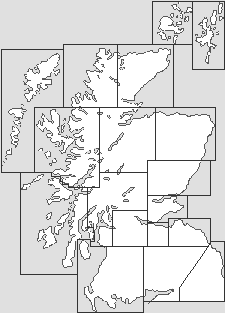 The Cross, with the Town Hall in the Background |
Paisley lies on either side of the White Cart Water, four miles south of where it joins the River Clyde at Renfrew. Though it takes a close look at a map to realise that Paisley hasn't quite physically merged with Glasgow, whose centre lies several miles to the north-east, the town has a distinct background and heritage, and retains an equally distinct identity.
The first settlement here grew up around a church overlooking a ford across the White Cart Water. This was established by the Celtic monk St Mirin who came to what was then the Kingdom of Strathclyde from Bangor in Northern Ireland in the late 500s. St Mirin is the patron saint of Paisley and his name is kept alive today in the St Mirin chapel in Paisley Abbey, built overlooking the river not far from the original church, in the name of St Mirin's Roman Catholic Cathedral, and in the name of Paisley's football club, St Mirren FC.
Paisley Abbey was established in 1163 by Walter Fitzalan and despite many setbacks went on to become a rich and powerful institution owning property throughout Ayrshire in the medieval period. A castle was built near the original ford over the White Cart Water some time before 1400, but all trace of it has now long gone.
The collapse of much of the Abbey in 1553, quickly followed by the Reformation in 1560, brought rapid change to Paisley. By 1600 it was the most significant settlement in Renfrewshire and in 1601 a tolbooth was built: it was rebuilt in 1750 and 1821, before being demolished as unsafe in 1870 and replaced on a different site by the magnificent Town Hall you see today.
The Town Hall was funded by Clarks, the owners of the Anchor thread mill. In response, their main competitor in the production of thread in the town, Sir Peter Coats, funded the building of the equally magnificent Paisley Museum and Library in 1871 (see left). These, and many other remarkably grand buildings in Paisley, testify to the power, influence and success of the textile industry in the town.
This had started in the 1600s when, according to one account, minor entrepreneurs who could not afford to begin manufacturing in Glasgow set up in Paisley instead. In 1700 a Miss Christian Shaw brought to Paisley the technique of spinning very fine linen thread allowing the manufacture of fine lawn material. New methods combined with innovative local designs, and as a result Paisley linens could be sold for more than those produced in London or Paris.
The population grew dramatically through the 1700s. During the century muslin and silk gauze manufacturing grew in importance, and by its end cotton was replacing flax. In the early 1800s cotton thread manufacture became the biggest game in town, though not before Paisley's ability to use patterns originating in India to produce fine shawls made paisley better known worldwide as a type of patterned cloth than as the place in which it was produced.
Paisley's entrepreneurial spirit fed some rather unexpected transport projects over the centuries. One was the Glasgow, Paisley and Ardrossan canal, designed to allow shipping to reach Glasgow from the coast. Why not simply dredge the River Clyde instead? They did, but not before part of the canal from Glasgow to Paisley had already been built. In the 1820s this was the route of a fast fly boat service using very light, shallow draught boats towed at speed by horses, and taking just 45 minutes to travel between Glasgow and Paisley.
Even more surprising was the launching of a steam carriage service using the turnpike road between Paisley and Glasgow in 1834. This ran for seven months before the trustees of the road became concerned that the carriages were causing damage, and hired men to make their passage more difficult. They probably did not expect a carriage to be overturned in the process, killing five passengers in the ensuing boiler explosion: but their actions succeeded in keeping motorised traffic off the roads for another 60 years or so.
In 1992 the town's technical college became the University of Paisley. In 2007 this merged with Bell College in Hamilton to become the University of the West of Scotland.
Today's Paisley is a surprise for those who know it only as a name on signs on the M8. Long gone is what was described as one of the smokiest towns in Scotland in 1887. Instead the town has made much of its impressive collection of magnificent buildings. Large parts of the centre are now pedestrianised and, when coupled with remnants of an old street pattern behind the main shopping areas, this is a town that really repays exploration.

|
|
|
Visitor InformationView Location on MapWhat3Words Location: ///points.sketch.flock |
 Paisley Town Hall |
 Methodist Central Hall |
 Sheriff Court |




